Operation: Berlin
Date: 24/25th March 1944 (Friday/Saturday)
Unit: No. 625 Squadron
Type: Lancaster III
Serial: ND641
Code: CF-T
Base: RAF Kelstern, Lincolnshire
Location: Albergen area, Netherlands
Pilot: W/O II. “Jack” John David Owen R/138002 RCAF Age 23. Killed
Fl/Eng: Sgt. “Bill” Wilfred Henry Broadmore 1437834 RAFVR Age 21. Killed
Nav: Sgt. “Tony” John Charles Anthony David Lavender 1398485 RAFVR Age 20. Killed
Air/Bmr: Fl/Sgt. “Spanky” Frank Berry Magee RCAF Age 20. Evaded (1)
W/Op/Air/Gnr: Sgt. “Casanova” Percival Henry Simpkin 1388315 RAFVR Age 22. Killed
Air/Gnr: Fl/Sgt. “Al” Harry William Nixon R/175117 RCAF Age 22. Killed
Air/Gnr: Sgt. “Hugam” William Clark 1371877 RAFVR Age 22. Killed
REASON FOR LOSS:
This account was prepared and written by Jack Albrecht with assistance of the late Frank Magee - the only survivor of the crew during this operation.
Search for the sole survivor:
“Those noisy beggars!” - my grandmother admonished, waving her garden hoe skyward. Low overhead, a formation of four Maritime Command Lancasters thundered. Jockeying for position, en route to a flypast at RCAF Base Comox, a half mile to the southeast. With their passage the windows on our old house rattled in protest. It would be many years before I understood her hostility towards this noisy foursome. In reality it was not the reverberating disturbance of their passage but the fact that one of their deceased stable mates had taken her youngest son and his crew on their final trip to Berlin in March 1944. Since my youth at Comox aviation fuel has compromised a small percentage of my circulation.
My uncle, John “Jack” David Owen, joined up with the RCAF in April 1942 despite the protestations of my grandparents. After initial training at High River, Alberta, on Tiger Moths he was selected as a bomber pilot and underwent multiengine training on Cessna Cranes at Claresholm. By November 1942 he had logged a total of 240 hours. After the transatlantic crossing followed a whirlwind refresher course on Tiger Moths and Oxfords. At the Operational Training Unit at Tilstock he crewed up and checked out on Whitley’s, Halifaxes and finally on Lancasters. His crew was a mixed “bag”, symbolic of the Commonwealth war effort (As described above)
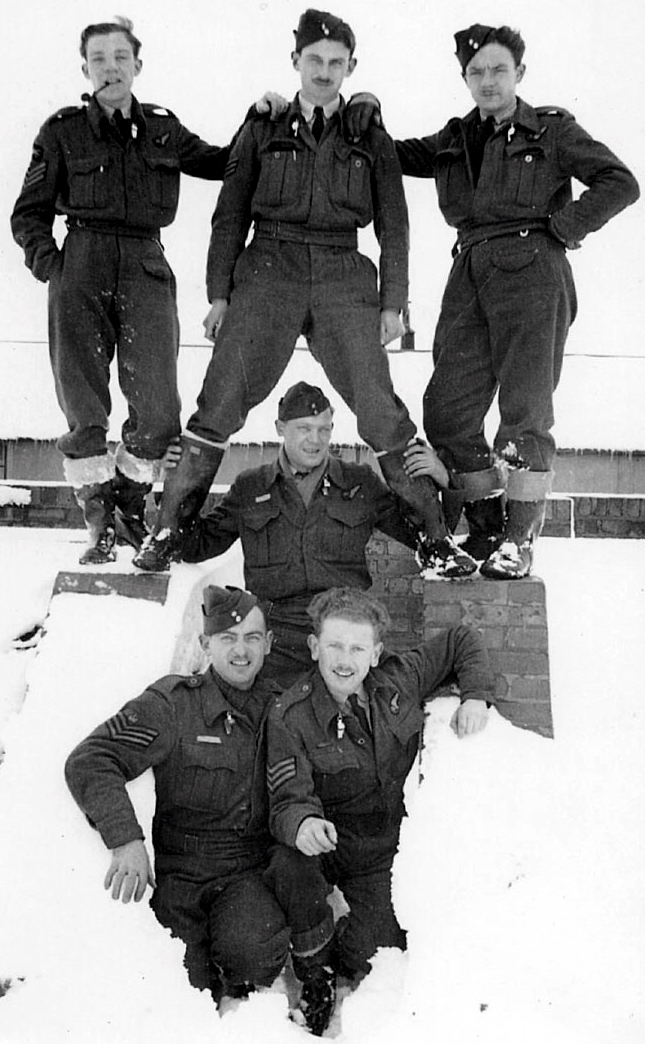
Above: Crew of ND-641 - 1944. Standing L-R: Sgt. Percival Simpkin, Sgt. John Lavender, Sgt. Wilfred Broadmore. Middle: Sgt. Harry Nixon. Kneeling: W/O Frank Magee, Sgt. William Clark.
A review of my uncle’s log book indicated a total of 23 red inked operational flights to enemy targets. Five of these had to be aborted due to equipment unserviceability including engine problems, oxygen failure and rear turret malfunction. Ten trips including the last was to the “Big City”, Berlin. The longest was to Stettin and was an incredible nine hour trip! The last entry for March 24/25, 1944 to Berlin had the following haunting comment under the Remarks column - “Missing - nothing heard”.
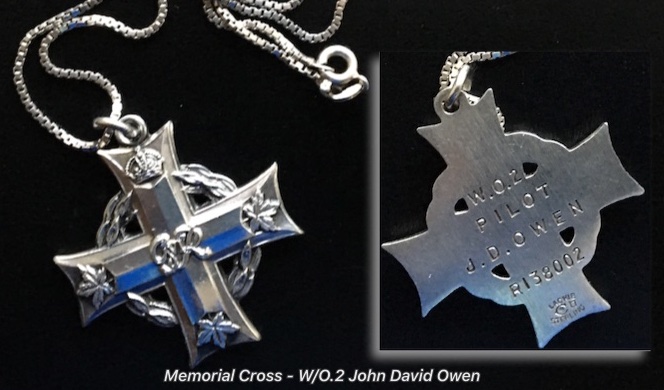
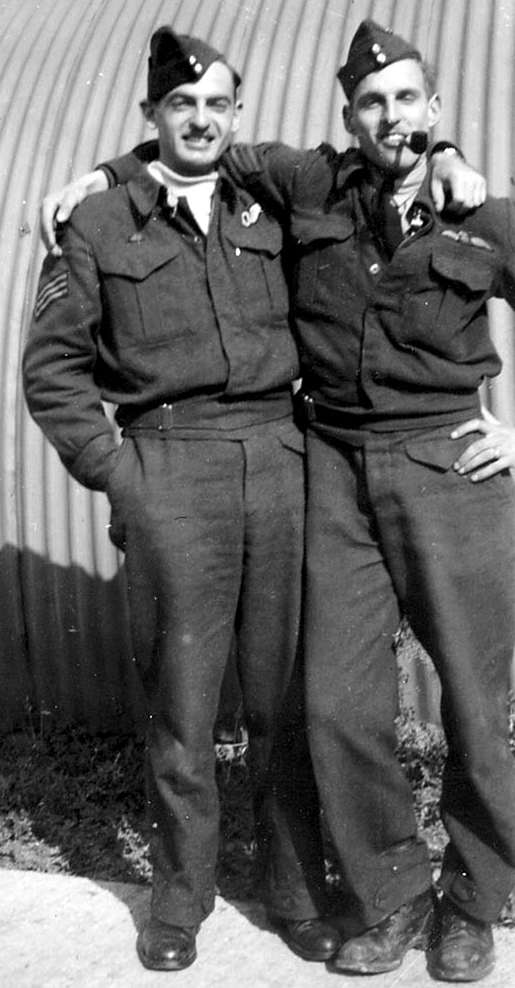
“Copy of account of operational flight of March 24-25: which was the date when Jack was reported missing, as written down by the bomb-aimer of the plane, which was a Lancaster bomber.
Left: Kelstern 1944 Frank Magee left with Jack Owen.
"We set course from base about 20:00 and headed for target, Berlin. One of our navigational aids failed about an hour out, but we still had to carry on. The winds during the whole trip were a way different from what we had been told on leaving base. We were in the first wave and as the wind was more or less behind us we arrived and overshot the target, no markers having been dropped as yet. We had a 100 mph gale to contend with heading back towards the target. We never did reach the target as it was time for all the bombers to head home; so we just dumped our load and headed for home.
We dodged flak and searchlights all the way back, and were way off track, and I think about an hour late. It was a clear night and I believe I saw the coast of Holland when the navigator called up to the engineer and asked him if we had enough gasoline for an hour’s flying, as it would take that long to reach England. The engineer said we were very low, and doubted if we would make it. Just then we could hear shells tearing through the kite, and as they came from exactly below we presumed it was flak. The plane was full of smoke and Jack opened the bomb doors to drop anything that might have stuck up and been on fire. However everything was gone and the draft cleared away the smoke. The mid upper gunner suggested that we do evasive action in case it happened again. Jack said, “Okay” and just started to do so when we were hit.
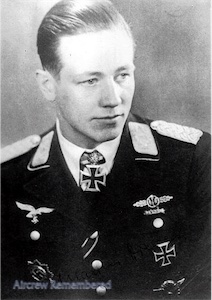
(Webmaster notes: ND641 was intercepted by Oblt. Martin Drewes (2) of Stab III./NJG1 at 6,000 mtrs with the Lancaster crashing at 00:20 hrs 50 km west of Rheine. This was his 16th claim - 3 being made on this night. The others: 57 Squadron Lancaster ND671, flown by 22 year old Australian pilot, P/O. George Alfred Hampton AUS/415527 killed with 4 crew, 2 taken PoW. 115 Squadron Lancaster LL694, flown by 21 year old, Fl/Sgt. James Arthur Newman from West Bromwich, Staffordshire, England, killed with 3 crew, 3 others taken PoW)
I could see tracer bullets flying past the nose so we all knew then it was a fighter. The plane immediately went into an almost vertical dive, and Jack shouted that he couldn’t control the kite, and shouted for the engineer to help him. I couldn’t get the escape hatch open during the dive, between them they managed to pull the plane out for a second or two. I flung open the hatch just as the inter-communication was cut; I could hear nothing over it. The engineer shouted my name and I saw him reaching for his chute so I jumped. I went down okay and landed in a small field just inside the Dutch border. I received immediate assistance from the Dutch Underground and was down in Belgium when Allied troops occupied the country".
Two days after I landed, the Dutch told me they had found the plane (not burned) with five bodies in it. Apparently the Germans later found the sixth.
I would just like to tell you how much I thought of Jack. He was a darn fine fellow, and a good pilot.”
This undated and unsigned document was stored in the attic and became part of our family history.
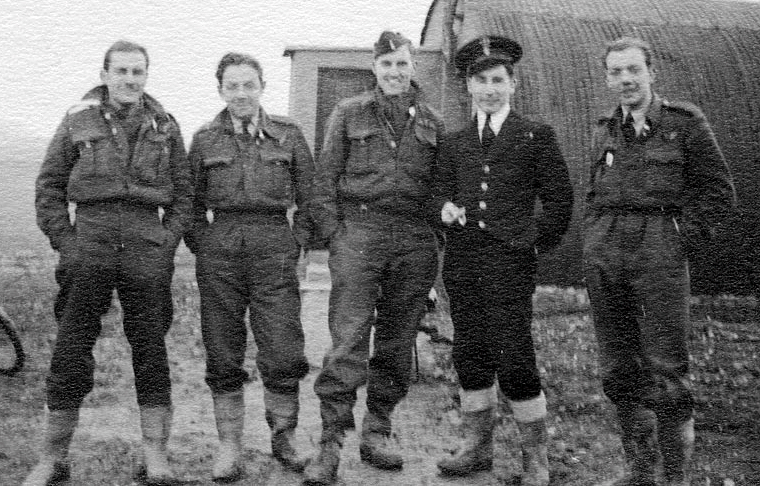
Above: Louth, England - 1943 "Lots of Mud". L-R: Al Normandin, Bill Broadmore, Jack Owen, Gordon Dark (RCNVR), Percy Simkin
My parents married in August 1944 and I entered the picture in January of 1946 - named John in memory of my uncle. During my childhood and formative years I often wondered of the whereabouts and welfare of the sole survivor. It was not until I had completed university that I had the time and resources to start a search. In 1974 I posted queries to the Air Historical Branch and Public Record Office in London, England. Mr. Hugh Tours from the Public Record Office rewarded me with handwritten notes from 625 Squadron after individual crew debriefings. This augmented the details from my uncle’s logbook but gave no information on the whereabouts of Frank Magee.Between 1982 and 1987 my efforts waned and the trail grew cold. Then during a visit to my parents in the summer of 1987 I perused a copy of my father’s “Legion” periodical. This lead to a last ditch effort with a search request in the next edition’s “Lost Trails” section. Two months later I had a chance to review my father’s July/August edition featuring Hampton Gray’s heroic attack in a Corsair. A glance at “Lost Trails” on page 61 revealed my search in print.
On returning home that weekend we were surprised to find a letter in unfamiliar handwriting in the mail slot. My heart raced - I knew that this was a missing link in my quest. Sure enough the letter was from “Chuck” Laidlaw of Kamloops, a boyhood chum of Frank’s. The contained information was a little vague but proved invaluable. Their last contact was in 1965-67 when Frank was employed in a municipal hall in Mission or some other Fraser Valley town. Armed with this information I had to strike while the iron was hot. Through the B.C. Tel Directory Assistance Operator I obtained the only listing for a Frank Magee in Abbotsford. My fingers trembled as I dialed the number — intuition told me that if a man answered the phone I would be able to tell if I had finally succeeded. To the best of my recollection, the conversation went like this:
“Hello” “Is this Frank Magee?” “Yes” “Is this Warrant Officer Frank Magee, RCAF. retired?” “Yes” - suspiciously. “Did you fly with 625 Squadron in March 1944 with a pilot named Jack Owen?” “Yes” - more suspiciously. Bingo!
After identifying myself and describing my tangential association through my uncle the tension melted away but I still had trouble controlling my tremor. After all these years and he was almost living in my backyard!
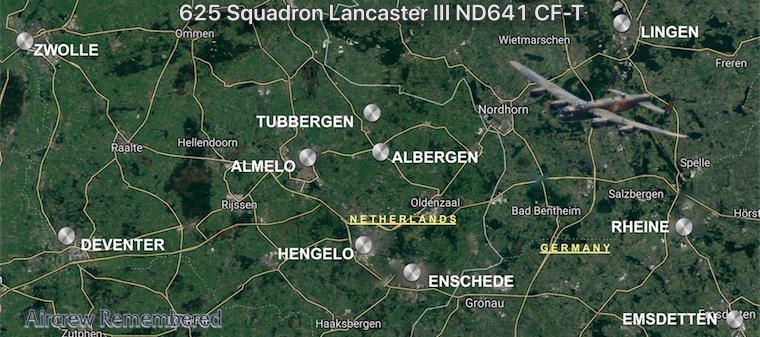
Two weeks later I met Frank and his effervescent wife, Vera, at their home in Abbotsford. Over lunch I learned of more intriguing pieces in the puzzle: After bailing out Frank parachuted to safety between Amelo and Hengelo near the Dutch-German border. He was immediately taken in by the Dutch Resistance and spent several days on the farm where Henk van Guens worked to avoid conscription to Germany as a slave labourer, before being moved by car and train to Belgium. After six months in the spartan life of an evader he was liberated when their town was overrun by the allies. On returning to England his first task was an unpleasant one - to tell Vera that her husband of three months, Percy Simpkin, had not survived their last mission. After the end of hostilities Frank returned to Canada. Vera followed two years later and they married in 1947. They have been soulmates ever since, raising their family in the splendour of the Fraser Valley. In appreciation of his heroic assistance, Frank sponsored Henk van Guens to immigrate to the Okanagan Valley after the war. Their friendship has continued to flourish ever since.
I was now left with two relatively simple tasks. The first was to visit the graves of my uncle and his crew in Tubbergen, Netherlands, to pay my respects 50 years after their last flight. With my adventuresome wife, Ruth, acting as navigator we struck off cross-country from Amsterdam in a rented car. The weather was horrific with blistering wind, pelting rain, driving sleet and even snow flurries - a bomber pilot’s nightmare! After several hours of wandering in this meteorological cauldron we found the needle in the haystack - the Roman Catholic Cemetery in Tubbergen. After a tip from Frank we also located Bertus Derksen who gave us a personal tour and narration during out visit. Fifty years prior he had been first on the crash site of Lancaster ND 641 and his memory had not been eroded with the passage of time. During our visit the incredible happened - the rain stopped, the clouds parted and the sun shone on the village and the cemetery. It was as if the resting souls knew we had come for a visit. This respite gave us time to appreciate how well kept the graves and headstones were of the two crews laid to rest here. As we left the cemetery the sun retreated and the storm returned with a vengeance for our return trip to Amsterdam.
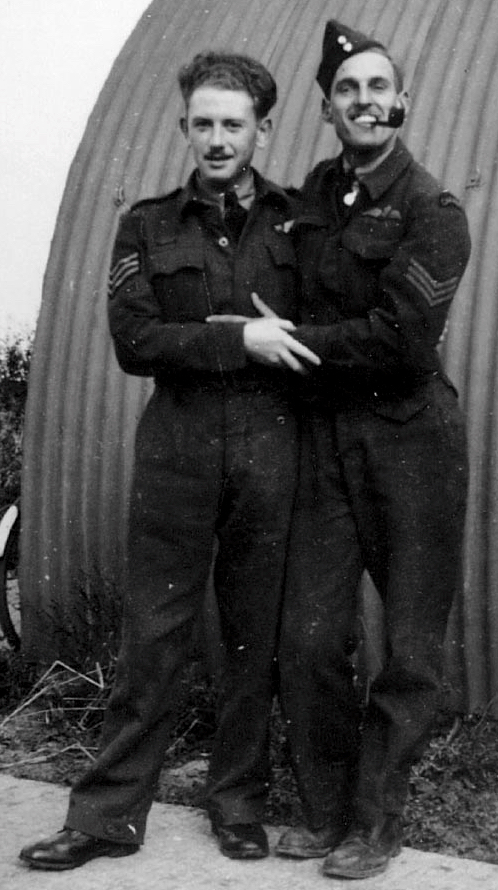
Right: Kelstern 1943, on left Sgt. “Hugam” William Clark with W/O. “Jack” John David Owen.
It is now over a decade since I located the sole survivor. During that time the friendship between our families has blossomed with visits, phone calls and Christmas cards. Each Remembrance Day now has a special significance and it is not complete without a call to Frank and Vera to confirm their well-being.
I am indebted to the Legion for completing this chapter in life for me - no, I will not forget.
Addendum: During a recent telephone conversation to review this article with Frank I was saddened to hear that Henk van Guens died suddenly from a heart attack in May 1988, at the age 78.
Two caterpillars and a goldfish:
In 1998, I wrote an article documenting the fate of Lancaster ND 641 and its crew on the evening of March 24/25, 1944, during the last major raid of the Battle of Berlin. The pilot, my uncle, Warrant Officer John Owen failed to return along with five of his crew mates - Sgt. Tony Lavender, Navigator; Sgt. Al Nixon, Mid-Upper Gunner; Sgt. Percival Simpkin, Signal Officer/Gunner; Sgt. Bill Broadmore, Flight Engineer; and Sgt. Bill Clark, Rear Gunner. Flt/Sgt. Frank Magee, Bomb Aimer, parachuted to safety and was liberated in 1944 as an evader. He returned to Canada after hostilities ceased and married the widow of his crew mate, Vera Simpkin.
In 1972, I initiated a search for Frank Magee. After 15 years, with the aid of an ad in the Legion Magazine’s “Lost Trails” department, the trail ended in Abbotsford. Just before publication of my article, “Uncovering the Lost Trail” (January/February 2001 issue), Dan Black, Managing Editor, commented that it is hard to predict the feedback 50 years post-event. My expectations were not high - I was wrong!
The Parachute:
After a barrage of telephone calls from friends and relatives, I received a parcel by registered mail from Joe Sweeney of Crescent Valley, BC. It contained a photo album and documents describing the 50 year history of Frank Magee’s parachute and harness.
After landing in a farm field, just after midnight, in Albergen, Holland, he was ushered into a farmhouse with his bundled parachute. Frank was conscripted on the spot to feed the farmer’s infant children boiled milk - before being taken under the wing of the Dutch Underground. In war torn Holland, his silk parachute was a rare commodity. The farmer’s wife did not hesitate to use a portion to sew communion dresses for her four daughters. The remainder was set aside and transformed into an ornate chasuble for her seminarian brother - Father Herman Engberink was ordained on March 24, 1946, two years after the crash of ND 641. Father Herman was assigned to a mission in Gold Coast. En route, his ship collided with a French Liberty vessel in the English Channel and he was forced to abandon ship - sans personal belongings. After rescue by a Royal Navy Destroyer, he continued his journey to Gold Coast. Several months later, an unexpected parcel arrived containing his personal effects including the indestructible vestment.
He eventually immigrated to Canada to become the priest of St. Rita’s Church in Castlegar, BC. On March 24, 1996, he celebrate the Jubilee Year of his priesthood wearing Frank Magee’s parachute cum chasuble.
Father Herman’s nephew, Bernard, was the infant fed by Frank in the early hours of March 25, 1944. He grew up to become a Social Studies teacher. Each year he introduces the lesson on the Second World War wearing Frank’s parachute harness. He uses this artefact to embellish Frank’s adventure with the Dutch Underground safe houses through to his liberation near Liège, Belgium.
In a recent telephone conversation with Joe Sweeney, he informed me that Father Herman is still alive and returned to Holland for his retirement years.
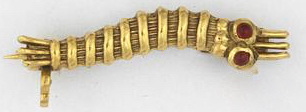
On October 14, 1944, Warrant Officer F.B. Magee received a congratulatory letter from Leslie Irvin inducting him into the Caterpillar Club. Membership was automatic to allied air crew whose life had been saved by an Irvin Chute. Frank still proudly displays his Silver Caterpillar pin on his RCAF wedge cap! I find it amazing that a single parachute could have such long lasting and far reaching impact - from the ravages of war to the serenity of peace, religion and education.
Before his departure for Holland, the Castlegar Branch of the Royal Canadian Legion was instrumental in initiating a liaison between Father Herman and Frank Magee. Father Herman was able to express his gratitude and enlightened Frank of the durability of his silk canopy.
Survivors:
The next surprise came as a letter from Mrs. Joan Berry forwarded courtesy of Dan Black at the Legion Magazine. After reading her letter, the significance was obvious - in March 1944, she was married to Sgt. Bill Broadmore, my uncle’s flight engineer. His loss left her a devastated widow with an eight-month-old son, Peter. She could vividly recollect her last visit with Bill, her mother and sister, as well as receiving his daily letters for three days after he was reported missing. She subsequently remarried and immigrated to Canada with her husband and Peter. Joan was kind enough to forward a photocopy of an October 1944 letter from my grandfather that captures the tragic atmosphere of families coming to grips with the sudden loss of young lives during wartime. In corresponding with Peter, he informed me that my article had brought him closer to a father he had never known. I would later learn that my Legion article was instrumental in Joan and Peter reestablishing ties with the Broadmore clan in England after a 20 year hiatus. It also gave me closure to the puzzle of the epitaph inscribed on Bill Broadmore’s headstone in Tubbergan, Holland:
“In memory’s garden, my darling you always will be”. Joan admitted authorship of this touching line.
A week later, I received a telephone call from John Munro of Chilliwack, BC. He informed me that Frank Magee’s story was not unique. He also participated in the March 24/25, 1944 raid on Berlin as a rear gunner of Lancaster ME 684 piloted by Flying Officer “Nobby” Clark. Their aircraft along with ND 641 and ED 317 (all from 625 Squadron) failed to return, falling to night fighters or flak. ED317, piloted by Flight Sergeant Jamieson, was lost with all crew members. John had vivid recall of that fateful mission many years ago. On the return leg, they were forced to abandon a flaming Lancaster riddled by flak. After “assisting” the mid-upper gunner, frozen by fear to exit via the rear escape hatch, John sought the safety of his parachute. All seven crew members survived - three evaders and four POWs. Like Frank Magee, John successfully evaded capture until liberated by advancing Allied forces. Despite this misfortune, he still had the appetite to fly a final combat mission in 1945.
Further information on ED317 described here.
At war’s end, he returned to Thunder Bay, raised his family, worked as an electrician and learned to fly. He moved to BC and retired with his wife in Chilliwack, BC.
I was fortunate to meet John on several occasions after flying into Chilliwack Airport. Short in stature, he compensated with an energetic friendly personality. After a near miss, driving to his home, I was assigned to chauffeur duties for future visits. He admitted that his vision was not what it used to be. At his home, he had a den dedicated to his war years and aviation adventures. This included Resistance photographs, forged documents, and identity papers from his escapades as an evader. After a visit, he would load me up with fresh produce from his vegetable garden.
Sadly, his health took a sudden turn and he departed on his last mission on Friday, September 13, 2002. I spoke to him the day before and knew that he was at peace with his fate.
I am still incredulous that Frank and John could survive bailing out of aircraft from the same squadron on the same night, evading capture, the next 50 years, and then live within ten miles of each other unaware of their celestial connection - in the end they did know.
The Legend of John Goldsmith, DFC, AFC, CD:
On January 24, 2001, I received a parcel with a treasure trove of documents from John Goldsmith. His introductory letter noted that he had participated on the March 24/25 Berlin Raid - and returned intact. He enclosed the battle order for the raid listing all 17 aircraft and crew as well as his personal notes, and a contemporary newspaper article on the raid. A list of operational missions by 625 Squadron from October 1943 to April 1944 included target names, aircraft dispatched (3 to 19) and losses for each mission. Losses varied from nil to three per raid. In addition, he provided contact addresses for Tim Dougal, an Oxford professor writing a book on the history of 625 Squadron and Ramsay Turner, Honorary Secretary of 625 Squadron RAF Memorial Association.
A follow-up phone call proved him to be a wealth of knowledge. His memory remains sharp as a tack and contrary to regulations, he kept notes on each mission flown. Following the Berlin raid he had vivid recollection of the disastrous Nuremberg trip later that month - brilliant moonlight and repeated explosions of bombers falling to flak or night fighters forced him to retreat to the seclusion of his navigation cubbyhole.
He recalls the raid at the end of February 1944 that was preceded by a heavy snowfall. Before take-off, air crew were called out to assist ground crew in shovelling runways clear. On the take-off run, their aircraft was damaged, losing its radome. En route, the mid-upper gunner was incapacitated by cold exposure and other crew members took turns manning his position to successfully complete the trip.
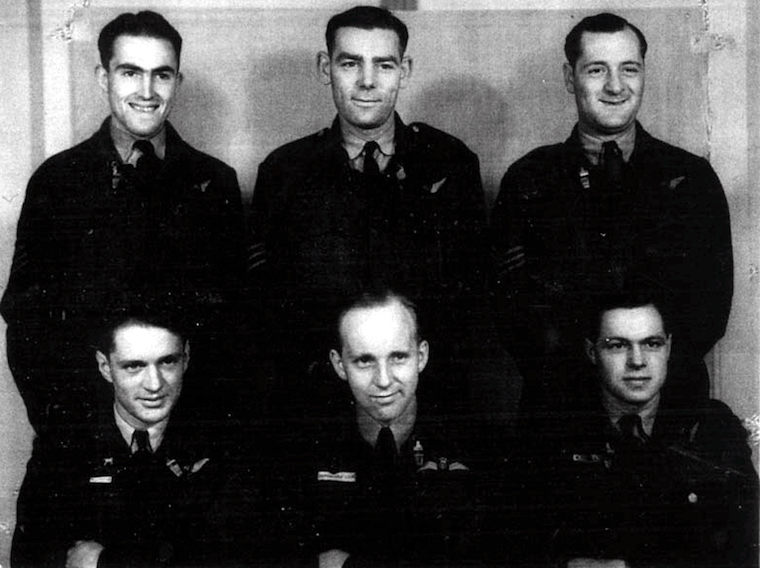
Above: rew Photo - May 1944. Front (L-R): P/O. John Goldsmith, navigator. P/O. Brad Bradshaw, pilot. Sgt. Skids Brakes, engineer. Back: Sgt. Bob Wright, wireless operator. Sgt. Jack Cavanaugh, rear gunner. Sgt. Butch Sutcliffe, mid-upper gunner. Missing: Jock Gunn, bomb aimer.
John completed his first tour with 625 Squadron and then volunteered with 156 Pathfinder Squadron. On his 44th operation, August 26/27, 1944 to Kiel, his credit account with Lady Luck hit a profound low. He was the volunteer navigator on Flt/Lt. Bob Etchells’ crew when they were mauled by a night fighter over the target. The combat resulted in the fighter retreating in flames but they did not escape unscathed - battle damage included two starboard engines disabled, port tail plane fragmented, bomb bay frozen open, and port main gear extended. The run for home base took a detour as the port inner engine caught fire - the mist shrouded North Sea beckoned. At this point, Lady Luck had second thoughts. Bob Etchells pulled off a textbook ditching at night on the unforgiving North Sea. All seven crew members survived, uninjured, to scramble into their leaking dinghy. It was none too soon as their Lancaster PB 302 slipped below the surface four minutes after ditching. The next day, they transferred to an airborne life raft dropped by an Air Sea Hudson. On the second day, they were plucked from their disintegrating craft by a Danish fishing boat. After transfer to an Air Sea Rescue Launch, they landed at Grimsby - 80 hours after leaving England. John has chronicled this adventure in the 1971 “The Lancaster at War” by Mike Garbett and Brian Goulding under the appropriate chapter “Seven more for the Goldfish Club”, a club exclusive to wartime air crew that survived a ditching.After this saga, John did not participate in wartime operations. He was awarded the Distinguished Flying Cross for gallantry in the performance of his duty while serving with 156 Squadron. The citation for the award read: “This officer has completed numerous operations against the enemy, in the course of which, he has invariably displayed the utmost fortitude, courage and devotion to duty.”
In October 1944, John returned to Canada and put in a request for flying duties that did not involve excursions over large bodies of water. He was promptly posted to the RCAF Meteorological Flight making 500 mile jaunts over the Atlantic between Yarmouth, Nova Scotia and Bermuda!
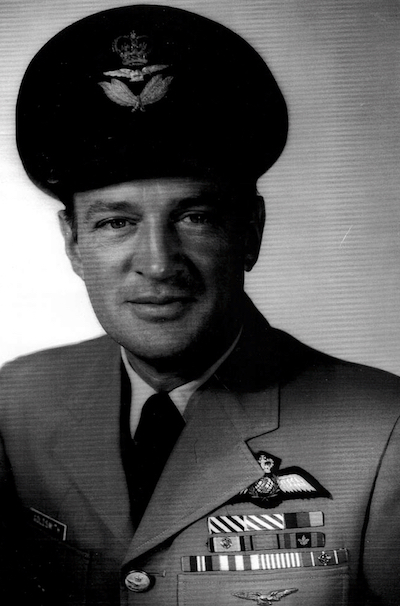
Left: Wing Commander John Goldsmith DFC, AFC May 1972
Excerpts from the citation by the Minister of National Defence gives example of the dangers involved:
“The Navigator, Flying Officer Goldsmith, was responsible for successfully guiding the aircraft through dangerous and uncharted areas in the Arctic Islands. In order to reach observation points surrounding the Magnetic Pole, it was frequently necessary to fly above the over-cast for many hours. With the minimum of normal meteorological and navigational aids, and the unreliable compass reading areas, this officer invariably directed the aircraft to its destination, often necessitating a let down through clouds in the vicinity of high hills or dangerous waters. Flying Officer Goldsmith did not have the assistance of accurate maps and his own sketches of important areas have been accepted for incorporation into official Dominion Government charts. The outstanding matter in which Flying Officer Goldsmith adapted himself to the difficult methods of navigation required over the pole is worthy of the highest praise. The successful completion of this pioneering operation was directly attributable to the resolute direction, integrity and initiative of this officer and his skilfulness and courage has set a fulgent example which will be an inspiration to his comrades in the Royal Canadian Air Force.”
During these flights, he was credited with rediscovering the Spicer Islands located in the Foxe Basin south of Baffin Island. In 1952, John was further honoured by the Ministry of Energy, Mines and Resources with Goldsmith Channel being named to acknowledge his contribution to northern geography. This body of water is located between the northeast tip of Victoria Island and Stefansson Island. It is indeed a rare accomplishment for someone still living to have a geographical landmark named after them.
His military career included station adjutant at Goose Bay and a two year stint with the USAF in Hawaii, participating in the Korean Airlift in 1951/52. After completion of Staff College in Toronto, he was selected for training as an airborne intercept observer to fly in CF-100 all-weather fighters. In 1960, he was given command of 425 All Weather Fighter Squadron and promoted to Wing Commander - a unique accomplishment for a navigator! Under his leadership the squadron was awarded the Steinhart Trophy - Most Efficient Fighter Squadron in Air Defence Command.
John closed out his 33 year military career with postings to NORAD as Deputy Director of Operations in Great Falls, Montana and Director of Operations in St. Margaret’s, NB. For the next 10 years he ran a tax and financial consulting business in Vancouver, BC, retiring in 1988 to Sidney, BC where John and Vicki, his petite energetic soul mate, enjoy their immaculate ground-level townhouse overlooking tranquil Tsehum Harbour. Born in Halifax, Nova Scotia, John has an inexplicable affinity for water - a true Goldfish through and through!
With the benefit of John Goldsmith’s excellent reference library, I was able to solve the mystery of Pilot Officer Al Normandin. In a 1943 sepia photograph of my uncle and his crew, in the gumboot swallowing mud of Kelstern, he is identified as the mid-upper gunner. However, by March 1944 he had been replaced by Sgt. Al Nixon. Frank Magee could remember an earlier mission from which he and Al Normandin were ordered as “spare bods” on separate crews. In the crew bus they sat across from each other en route to the aircraft dispersals. On disembarking at his Lanc, Al held out his hand and wished Frank “Good Luck”. Frank shook his hand and responded, “I will see you for breakfast Al” - Frank kept his part of the bargain, Al Normandin failed to return. I found the answer in the appendix of Alan Cooper’s “Bombers Over Berlin”. The crew of Lancaster JB 122, piloted by Flt/Sgt. R. Gallop are all listed as killed on the January 30/31, 1944 Berlin raid. PO Al Normandin was listed as the mid-upper gunner of that crew. The cause of their demise (flak, night fighter or mid air collision) and place of rest are not noted - such are the fickle fates of war.
I found it remarkable that my original article brought to light two Caterpillars - Frank Magee and John Munro - and one Goldfish, John Goldsmith, alive and well over 50 years after their common connection as air crew of 625 Squadron over Berlin on March 24/25, 1944. It has increased my resolve not to forget on November 11th - a minute of reflection for my Uncle Jack and John Munro and a telephone call to Frank Magee and John Goldsmith to maintain contact.
(1) Frank Magee died on the 15th August 2013, two days short of his 94th birthday in Osoyoos, British Columbia, Canada.
(2) Martin Drewes - born on 20th October 1918 near Hannover - became a night fighter ace in the Luftwaffe - claiming 5 on the Mailly-Le-Camp operation alone. Eventually claiming a total of 43 allied aircraft flying mainly the Bf110. He survived the war emigrating to Brazil where he married a Brazilian lady. His wife died in 2010, he died later on the 13th October 2013 at Blumenau, Brazil age 94.
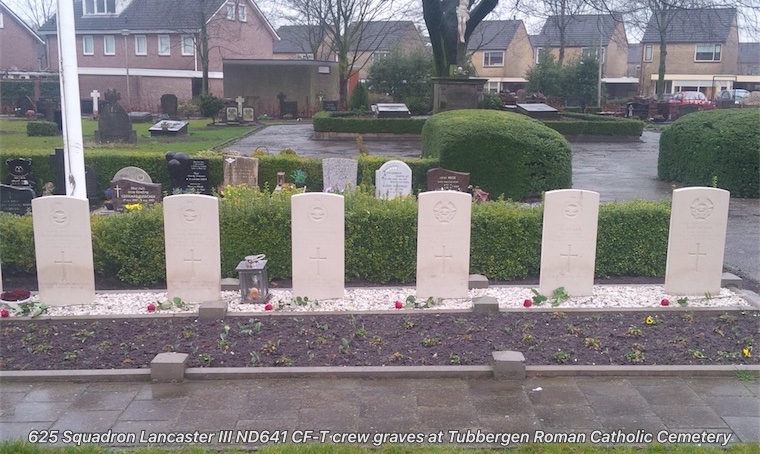
Above as described - Taken by taken by Frank Magee's daughter and son-in-law when they visited the cemetery to reunite Frank's aliquot of ashes with his crew mates. The red roses in the photo are symbolically pointed to Kelstern, England.
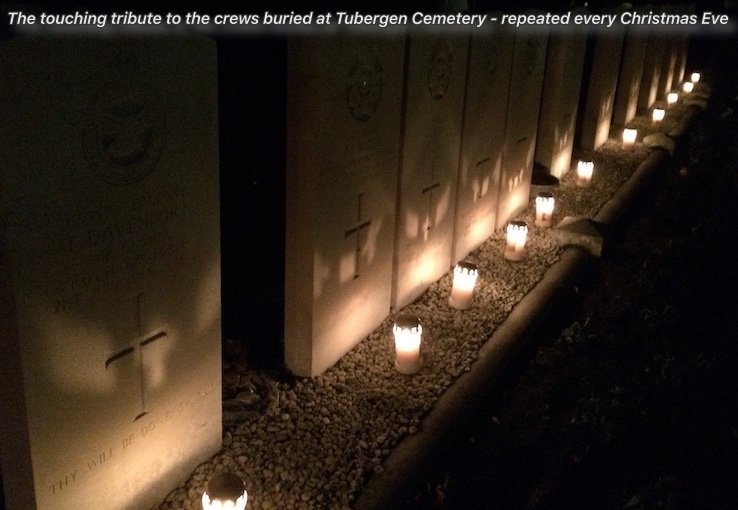
Tubbergen Roman Catholic Cemetery. Every Christmas Eve a candlelight vigil is performed at the cemetery and on Remembrance Day flowers are left at the graves. Mr. Mark Veldshuis, a local school teacher, organises this with the help of his students. Mark is also a volunteer at the Holten Canadian war cemetery Information Centre.
For acts of valour, courage or devotion to duty: Suggested decorations, R138002 W/OII J.D. Owen- DFC and 1437834 Sgt. W.H. Broadmore- DFM. Both KIA, eyewitness account.
Burial details:
W/O II. John David Owen. Tubbergen Roman Catholic Cemetery. Grave 3. Born on the 11th September 1920, the son of Percy Llewellyn Owen and Julia Ada Gaunt of Comox, British Columbia, Canada.
Sgt. Wilfred Henry Broadmore. Tubbergen Roman Catholic Cemetery. Grave 6. Son of James William and Ada Broadmore, of East Ham, Essex, England and husband of Joan Broadmore. Grave inscription reads: "In Memory's Garden, My Darling You Always Will Be".
Sgt. John Charles Anthony David Lavender. Tubbergen Roman Catholic Cemetery. Grave 4. Son of Percy Charles and Alice Mary Lavender, of Hutton, Essex, England. Grave inscription reads: "Greater Love Than This No Man Hath, That A Man Lay Down His Life For His Friends".
Sgt. Percival Henry Simpkin. Tubbergen Roman Catholic Cemetery. Grave 5. Son of George H. and Alice J. Simpkin, of Kennington, London, England and husband of Vera F. Simpkin. Grave inscription reads: "Silent Thoughts And Memories Keep You Ever Near Us. Mum, Dad And Sister".
Fl/Sgt. Harry William Nixon. Tubbergen Roman Catholic Cemetery. Grave 1. Son of Dalton Chester Nixon (deceased) and Clara May Cable of Toronto, Ontario, Canada.
Sgt. William Clark. Tubbergen Roman Catholic Cemetery. Grave 2. Son of Frank and Margaret Clark, of Ayr, Scotland. Grave inscription reads: "For Ever Remembered".
Researched by Jack Albrecht and Frank Magee and dedicated to the relatives of this crew with thanks to sources as shown.